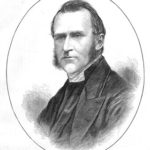Many examples could be cited that would trace the holiness movement’s departure from early Methodism’s heritage and teachings. One important example of such departure is found in the instructions currently given to those who are seeking holiness of heart or Christian perfection. Directions normally received by such seekers today have an unmistakable origin in the teachings of persons other than Mr. Wesley. One of those persons was a lady by the name of Phoebe Palmer.
Phoebe Palmer was one of the influential personalities of the holiness movement in the last century. She was the principal sponsor of a weekly prayer meeting held in New York City, beginning in 1835. This meeting was held every Tuesday for the said “promotion of holiness.” In the years that followed, the Tuesday Meeting became popular in many places across this nation. Some believed that such a meeting was “filling a void left by the gradual death of the Methodist class meeting.” Although she was not theologically trained, Mrs. Palmer was a strong-minded woman, successfully gathering an impressive following that included bishops, denominational leaders, ministers, educators, and lay people of various denominations. As a self-appointed teacher, she added some of her own peculiar twists to the doctrine of Christian perfection which continue to the present day.
Among a number of her teachings that departed from orthodox Wesleyanism, Mrs. Palmer taught that consecration was the condition for entering into entire sanctification. Once consecration was complete the believer was to exercise faith and, without any sensible evidence lay claim to this inward work. One of her favorite scriptural texts was, “The altar . . . sanctifieth the gift.” This gave rise to what was eventually called “the altar terminology.”
Let us now observe Mr. Wesley’s contrasting views concerning scriptural entrance into this experience and how he believed we could know that we had attained. The following is in question and answer form and had its origin in the Methodist Conference session of 1759. Christian perfection was “largely considered” at that gathering and some of the discussion was later published in Mr. Wesley’s Plain Account of Christian Perfection.
Q. When may a person judge himself to have attained this [perfection or entire sanctification]?
A. When, after having been fully convinced of inbred sin, by a far deeper and clearer conviction than that he experienced before justification, and after having experienced a gradual mortification of it, he experiences a total death to sin, and an entire renewal in the love and image of God, so as to rejoice evermore, to pray without ceasing, and in everything to give thanks. Not that “to feel all love and no sin” is a sufficient proof. Several have experienced this for a time, before their souls were fully renewed. None therefore ought to believe that the work is done, till there is added the testimony of the Spirit, witnessing his entire sanctification, as clearly as his justification.
Mr. Wesley acknowledged the fact that “some imagine they are sanctified, when in reality they are not.” He believed the reason to be that “they do not judge by all the preceding marks, but either by part of them, or by others that are ambiguous.”
After explaining the gradual and instantaneous process of “death to sin, and renewal in love” experienced by serious seekers after perfection, Mr. Wesley comes to a consideration of that question about which we are most concerned in this discussion. How are seekers after entire sanctification to be directed? What are the conditions to be met? He gives answer in the following:
Q. How are we to wait for this change?
A. Not in careless indifference, or indolent inactivity; but in vigorous, universal obedience, in a zealous keeping of all the commandments, in watchfulness and painfulness, in denying ourselves, and taking up our cross daily; as well as in earnest prayer and fasting, and a close attendance on all the ordinances of God. And if any man dream of attaining it any other way, (yea, or of keeping it when it is attained, when he has received it even in the largest measure,) he deceiveth his own soul. It is true, we receive it by simple faith: But God does not, will not, give that faith, unless we seek it with all diligence, in the way which he hath ordained.
This consideration may satisfy those who enquire, why so few have received the blessing. Inquire, how many are seeking it in this way: and you have a sufficient answer.
Prayer especially is wanting. Who continues instant therein? Who wrestles with God for this very thing? So, “ye have not, because ye ask not; nor because ye ask amiss,” namely, that you may be renewed before you die. Before you die! Will that content you? Nay, but ask that it may be done now; today, while it is called today. Do not call this “setting God a time.” Certainly, today is his time as well as tomorrow. Make haste, man, make haste! Let thy soul break out in strong desire the perfect bliss to prove; thy longing heart be all on fire to be dissolved in love!
We have observed that “complete consecration” was stressed by Phoebe Palmer as the seeker’s single condition for entering into the experience of Christian perfection. Following this formula, those seekers were then to believe that the work was done and lay claim to it, even in the absence of God’s witness to their hearts. This teaching continues to the present time as the most popular and prevalent formula for one’s entrance into an experience of holiness of heart.
It should be pointed out that Mr. Wesley did not overlook the necessity of dedication and consecration. The text of his Covenant Service is sufficient proof of this. He believed in the necessity of being “inwardly and outwardly devoted to God; all devoted in heart and life.” To suppose, however, that he considered one to be truly justified and regenerated in heart who had not already consecrated himself in full devotion to Christ is to misunderstand Mr. Wesley. He considered Christ as necessarily Lord of all who have been justified or initially saved. To deny Him as Lord by withholding full devotion would be to exclude Him as Savior.
We see that under Mrs. Palmer’s direction, seekers after sanctification were to be their own judges concerning the accomplishment of this inward work. No “witness of the Spirit” seems to have been necessary. Nor was it necessarily to be looked for. The seeker determined for himself when he had met conditions and provided a “testimony” of his own making. Last of all he was required by Mrs. Palmer to make public his own testimony of having attained the blessing of entire sanctification.
With such a teaching still prevailing to the present time, is it any wonder that we see so little evidence of holy living? It is absolutely imperative that the scriptural truth known and taught among eighteenth century Methodists be revived one again. This, we believe, is the vital key to another such movement of God in our time.
McPherson, Joseph D. “How Is One To Seek The Experience Of Christian Perfection?” The Arminian: A Publication of the Fundamental Wesleyan Society, 1996, vol. 14, no. 1. http://wesley.nnu.edu/arminianism/the-arminian-magazine/the-arminian-magazine-spring-1996/. Print.





